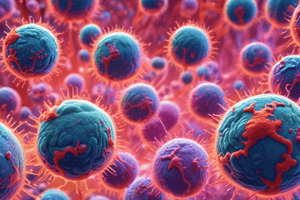Podcast
Questions and Answers
What is a key characteristic of cytomegalovirus (CMV) infections in hematopoietic cell transplant (HCT) patients?
What is a key characteristic of cytomegalovirus (CMV) infections in hematopoietic cell transplant (HCT) patients?
- Patients with HCT do not require any form of monitoring for CMV.
- CMV has no impact on the outcome of HCT procedures.
- CMV typically causes mild symptoms in all patients.
- CD8 T cells play a significant role in controlling CMV infections. (correct)
Which of the following populations is particularly at risk for CMV-related diseases?
Which of the following populations is particularly at risk for CMV-related diseases?
- Pregnant women and their fetuses. (correct)
- Individuals with high CD4 T cell counts.
- Individuals with no prior exposure to CMV.
- Healthy individuals with robust immune systems.
How does CMV evade the immune system?
How does CMV evade the immune system?
- By suppressing all forms of immune response permanently.
- By enhancing the production of antibodies against itself.
- Through the downregulation of MHC molecules on infected cells. (correct)
- By solely infecting and destroying immune cells.
What condition was the patient diagnosed with six months after the transplant?
What condition was the patient diagnosed with six months after the transplant?
What is a primary reason for focusing on congenital CMV infection in vaccine development?
What is a primary reason for focusing on congenital CMV infection in vaccine development?
Which T cell type is primarily responsible for controlling CMV infections in individuals?
Which T cell type is primarily responsible for controlling CMV infections in individuals?
What was the likely reason for the patient's respiratory failure after the transplant?
What was the likely reason for the patient's respiratory failure after the transplant?
What is the mechanism by which ganciclovir works against herpesviruses?
What is the mechanism by which ganciclovir works against herpesviruses?
What characterizes the immune response of an immunocompetent host to HCMV?
What characterizes the immune response of an immunocompetent host to HCMV?
What contributes to the high risk of infection in transplant recipients post-transplant?
What contributes to the high risk of infection in transplant recipients post-transplant?
What distinguishes HCMV-specific CD8+ T cells from resting memory cells?
What distinguishes HCMV-specific CD8+ T cells from resting memory cells?
Why are HCMV+ transplant patients who develop HCMV-specific CD8 cytotoxic T cell responses at low risk for pneumonia?
Why are HCMV+ transplant patients who develop HCMV-specific CD8 cytotoxic T cell responses at low risk for pneumonia?
What role do HCMV-specific CD4 T cells play in the immune response?
What role do HCMV-specific CD4 T cells play in the immune response?
In HIV patients with low CD4+ T cell counts, why is there still a high risk for diseases like chorioretinitis?
In HIV patients with low CD4+ T cell counts, why is there still a high risk for diseases like chorioretinitis?
What is the likely reason for CMV's persistent challenge to the host immune system?
What is the likely reason for CMV's persistent challenge to the host immune system?
What is the typical presentation of cytomegalovirus (CMV) infection in immunocompetent individuals?
What is the typical presentation of cytomegalovirus (CMV) infection in immunocompetent individuals?
Which of the following is NOT a common manifestation of cytomegalovirus (CMV) disease in immunocompromised patients?
Which of the following is NOT a common manifestation of cytomegalovirus (CMV) disease in immunocompromised patients?
What is a leading infectious cause of hearing loss in neonates due to cytomegalovirus (CMV) congenital infection?
What is a leading infectious cause of hearing loss in neonates due to cytomegalovirus (CMV) congenital infection?
In immunocompetent hosts, CMV is kept under control by which immune response mechanism?
In immunocompetent hosts, CMV is kept under control by which immune response mechanism?
What is the most common manifestation of cytomegalovirus (CMV) disease in transplant patients?
What is the most common manifestation of cytomegalovirus (CMV) disease in transplant patients?
What typically occurs upon reactivation of CMV in immunocompromised patients?
What typically occurs upon reactivation of CMV in immunocompromised patients?
Which term describes the condition caused by the appearance of HCMV-specific TH1 CD4+ helper T cells during primary CMV infection?
Which term describes the condition caused by the appearance of HCMV-specific TH1 CD4+ helper T cells during primary CMV infection?
Which symptom is associated with congenital CMV infection in neonates?
Which symptom is associated with congenital CMV infection in neonates?
What plays a critical role in controlling cytomegalovirus (CMV) during primary infection?
What plays a critical role in controlling cytomegalovirus (CMV) during primary infection?
What can exacerbate the situation of unchecked CMV replication in immunocompromised patients?
What can exacerbate the situation of unchecked CMV replication in immunocompromised patients?
What is the role of CD8+ T cells in the context of HCMV?
What is the role of CD8+ T cells in the context of HCMV?
What is a significant risk factor for CMV disease in AIDS patients?
What is a significant risk factor for CMV disease in AIDS patients?
Which of the following is a key characteristic of HCMV?
Which of the following is a key characteristic of HCMV?
What mechanism does CMV use to evade the immune response?
What mechanism does CMV use to evade the immune response?
Why might long-term ganciclovir therapy not prevent pneumonia in HCMV?
Why might long-term ganciclovir therapy not prevent pneumonia in HCMV?
What remains unknown regarding HCMV despite vaccination efforts?
What remains unknown regarding HCMV despite vaccination efforts?
Which of the following is a common transmission route for HCMV?
Which of the following is a common transmission route for HCMV?
What condition is characterized by severe disease due to HCMV in neonates?
What condition is characterized by severe disease due to HCMV in neonates?
Study Notes
Cytomegalovirus (CMV)
- CMV is enveloped and contains double-stranded DNA.
- CMV can be latent and re-activate.
- CMV is transmitted via urine, saliva, sex, and organ transplants.
- CMV can cause severe disease in newborns and potentially fatal end-organ disease in immunocompromised individuals.
- CMV can cause mononucleosis in immunocompetent patients.
CMV and the Immune System
- Viral-specific CD8+ T cells are essential for controlling CMV infection.
- HCMV-specific CD8 T cells are effector cells, not resting memory cells.
- Patients who receive HCMV-specific CD8+ T cells through infusion have a significantly lower risk of death or severe disease from CMV.
- CD4+ T cells are crucial for limiting viral shedding and preventing tissue dissemination.
- AIDS patients with low CD4+ T cell counts are at high risk for CMV disease, especially retinitis.
CMV Immune Evasion
- CMV has multiple proteins that help it evade the immune system.
- CMV can interfere with MHC class I and II antigen presentation to prevent T cell recognition.
- CMV can inhibit natural killer (NK) cell activation, which is important for early immune response.
- CMV can disable the interferon response, which is a critical antiviral pathway.
- CMV can interfere with the detection of viral DNA by pattern recognition receptors (PRRs).
- CMV can produce chemokine mimics to recruit immune cells, potentially distracting them from the site of infection.
Vaccine Development
- CMV immune evasion mechanisms make it difficult to achieve sterilizing immunity or long-lasting protection.
- The correlates of protection for CMV are still poorly understood.
Studying That Suits You
Use AI to generate personalized quizzes and flashcards to suit your learning preferences.
Related Documents
Description
This quiz explores the characteristics of Cytomegalovirus (CMV), its transmission methods, and its effects on the immune system. Learn about the role of T cells in controlling CMV infection and how the virus evades immune responses. Test your knowledge on the implications of CMV in immunocompromised individuals and newborns.




